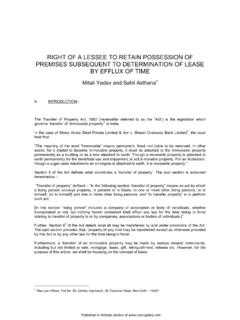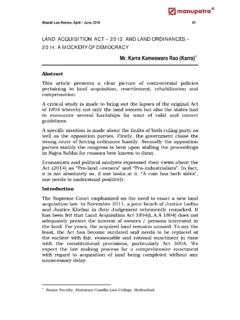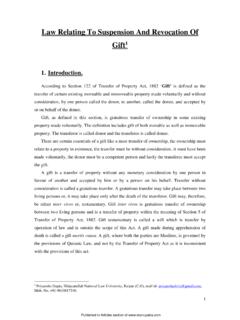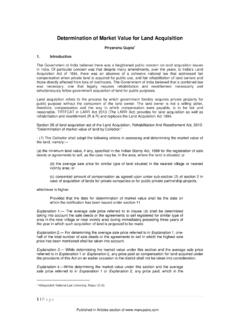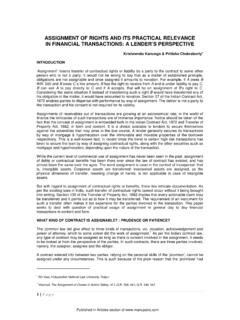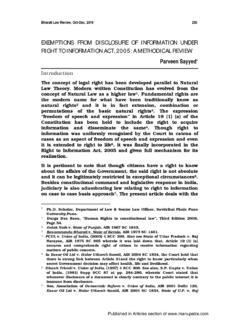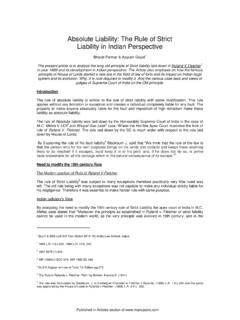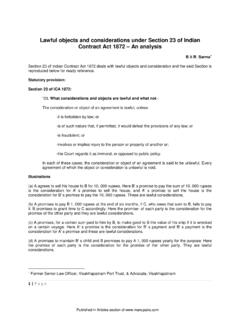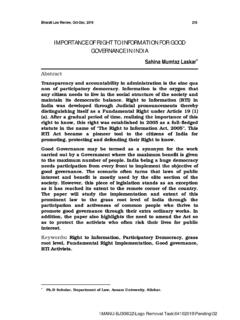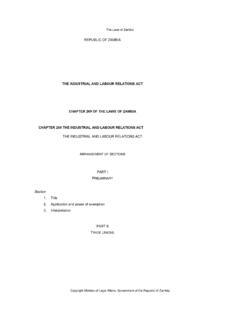Transcription of Judicial Activism in India
1 Bharati Law Review, Jan. March, 2017 1 Judicial Activism in India Prof. Dr. Nishtha Jaswal Dr. Lakhwinder Singh Introduction Under the Indian Constitution, the State is under the prime responsibility to ensure justice, liberty, equality and fraternity in the State is under the obligation to protect the individuals fundamental rights and implement the Directive Principles of State Policy. In order to restrain the State from escaping its responsibilities, the Indian Constitution has conferred inherent powers, of reviewing the State s action, on the courts. In this context, the Indian judiciary has been considered as the guardian and protector of the Indian Constitution. Considering its constitutional duty, the Indian judiciary has played an active role, whenever required, in protecting the individuals fundamental rights against the State s unjust, unreasonable and unfair actions/inactions.
2 Black s Law Dictionary defines Judicial Activism as: a philosophy of Judicial decision -making whereby judges allow their personal views about public policy, among other factors, to guide their decisions, usually with the suggestion that adherents of this philosophy tend to find constitutional violations and are willing to ignore precedent . Constitutional powers of the supreme court and High Courts in India Judicial Activism happens when the courts have power to review the State action. Article 13 read with Articles 32 and 226 of the Indian Constitution gives the power of Judicial review to the higher judiciary to declare, any legislative, executive or administrative action, void if it is in contravention with the Constitution. The power of Judicial review is a basic structure of the Indian Professor, Former Chairperson, Department of Law, Panjab University, Chandigarh.
3 Assistant Professor, National Law University, Delhi. 1 The Constitution of India , 1950, the Preamble. 2 L. Chandra Kumar v. Union of India , (1997) 3 261. Published in Articles section of Law Review, Jan. March, 2017 2 Article 32 of the Indian Constitution gives right to every individual to move directly to the supreme court of India for the enforcement of his or her fundamental right. Article 32 confers power on the supreme court to issue any order or writ for the enforcement of any of the fundamental rights. The supreme court in Fertilizer Corporation Kamgar Union v. Union Of India3 held that the power of the supreme court under Article 32 is an integral part of the basic structure of the Indian Constitution because it is meaningless to confer fundamental rights without providing an effective remedy for their enforcement, if and when they are violated.
4 It cannot be suspended even during emergency. An appropriate writ/order under Article 32 for the enforcement of Articles 17, 23 and 24 can be passed against a private individual Increasingly, the supreme court has interpreted Article 32 in a very liberal manner in many cases in order to enforce fundamental rights even against the private entities performing public functions. Article 226 of the Indian Constitution gives power to the High Courts to issue any appropriate order or writ for the enforcement of fundamental right and other legal rights. In this context, the jurisdiction of High court under Article 226 seems wider than the jurisdiction of supreme court under Article 32. Both Articles 32 and 226 are basic structure of the Indian Constitution. Article 227 further gives power of supervisory control to the High court over the subordinate courts, special courts and tribunals. Furthermore, the supreme court has power to grant special leave to appeal from any judgment, decree, determination, sentence or order in any cause or matter passed by any court or tribunal under Article 136 of the Indian Constitution confers special power on.
5 The supreme court exercises its special power in those cases where gross injustice happens or substantial question of law is involved. Power under Article 136 is discretionary one and can be exercised to decide the case on justice, equity and good However it should be used with proper care and caution. In Pritam Singh v. The State,6 the supreme court said that wide discretionary power under Article 136 should be exercised 3 1981 344. 4 People s Union for Democratic Rights v Union of India , (1982) 3 235. 5 Union of India v. C Damani and Co., 1980 Supp. 707. 6 1950 169. Published in Articles section of Law Review, Jan. March, 2017 3 sparingly and in exceptional cases only. In Tirupati Balaji Developers Pvt. Ltd. v. State of Bihar,7 the supreme court said that Article 136 does not confer a right of appeal on a party but vests a vast discretion in the supreme court meant to be exercised on the considerations of justice, call of duty and eradicating injustice.
6 Again, curative petition has been invented by the higher judiciary in order to prevent abuse of process or to cure gross miscarriage of justice. It is also maintainable in case of violation of the principles of natural The apex court in Rupa Hura judgment in 2002 said that the Bench considering curative petitions should have the three top judges of the supreme court . One of the most important constitutional provisions giving extraordinary power to the supreme court is Article 142 of the Indian Constitution. This provision empowers the supreme court to pass suitable decree or order for doing complete justice in any pending matter before it. Despite the fact that the law-making power in India lies primarily with the Parliament only, the supreme court is able to legislate under Article 142 of the Indian Constitution. This provision is responsible for the Judicial legislation in India . However, the Judicial legislation is being done only when there is vacuum in law on the concerned subject-matter.
7 The directions or rules issued by the supreme court under Article 142 would remain into force until the Parliament makes proper legislation on the subject matter. It means that the court understands the fact that appropriate law-making body is the Parliament only. For Parliament has more resources the supreme court to pass suitable legislation on the subject-matter. In Vishaka v. State of Rajasthan,9 the supreme court held that in the absence of enacted law to provide for the effective enforcement of the basic human right of gender equality and guarantee against sexual harassment and abuse, more particularly against sexual harassment at work places, we lay down the guidelines and norms specified hereinafter for due observance at all workplaces or other institutions, until a legislation is enacted for the purpose. This is done in exercise of the power available under Article 32 of the Constitution for enforcement of the fundamental rights and it is further emphasized that this would be treated as the law declared by this court under Article 141 of the Constitution.
8 7 2004 2351. 8 Rupa Ashok Hurra v. Ashok Hurra, (2002) 4 388. 9 1997 3011. Published in Articles section of Law Review, Jan. March, 2017 4 Considering the importance of Article 32 read with Article 142, it becomes necessary for the judiciary that it should perform its constitutional obligation where there is no legislation on the certain field and implement the rule of Again, the supreme court in Kalyan Chandra Sarkar v. Rajesh Ranjan,11 acknowledged the importance of Article 142 of the Indian Constitution and said that the court has power under Article 142 to issue directions and guidelines for implementing and protecting the fundamental rights in the absence of any enactment. The court reiterated that any such direction, filling up the vacuum of legislation, is the law of the land. However, the Parliament has power to replace such directions the Sexual Harassment of Women at Workplace (Prevention, Prohibition and Redressal) Act, 2013 replaced the Vishakha Guidelines for prevention of sexual harassment issued by the Hon ble supreme court of India in the year of 1997.
9 Judicial Activism and shift from locus standi to public interest litigation Access to justice is a fundamental aspect of rule of law. If the justice is not accessible to all, establishment of the rule of law is not possible. The individuals fail to reach justice system due to various reasons including lack of basic necessities, illiteracy, poverty, discrimination, privacy, poor infrastructure of the justice system, etc. The supreme court of India has recognised in many landmark judgments that access to justice is a fundamental Indian Judiciary has played an active role in ensuring access to justice for the indigent persons, members belonging to socially and educationally backward classes, victims of human trafficking or victims of beggar, transgender, etc. Since Independence, the Courts in India have been adopting innovative ways for redressing the grievances of the disadvantaged persons.
10 In many cases, the supreme court exercised its epistolary jurisdiction13 and took suo motto actions on mere postal letters disclosing the human rights violations in society. Human rights violations, which published in the newspapers, were taken into Judicial consideration. The court entertains the petitions which are being filed by the public spirited persons in the public interest. By doing so, the superior courts have liberated themselves from the shackles of the principle of 10 Vineet Narain v. Union of India , 1998 889. 11 2005 972. 12 Imtiyaz Ahmad v. State of Uttar Pradesh, 2012 642. 13 Sunil Batra v. Delhi Administration, (1978) 4 494. Published in Articles section of Law Review, Jan. March, 2017 5 locus standi and given the birth to the Public interest litigation in India . The shift from locus standi to public interest litigation made the Judicial process more participatory and democratic.
